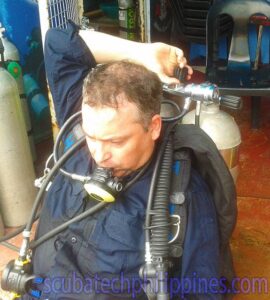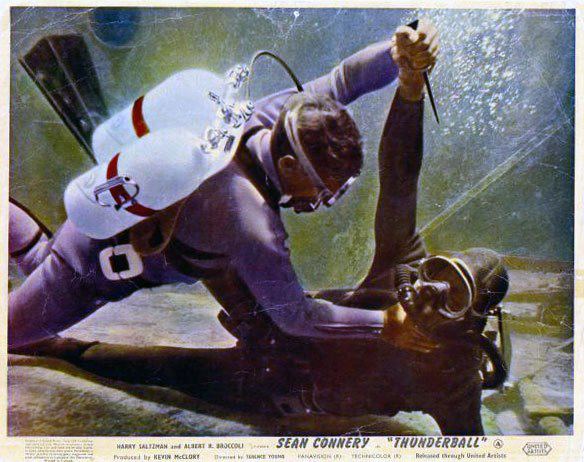Top-5 Tips to Perform Technical Diving Valve Drills
When learning technical diving, many students will remark that mastering backmount valve drills can be amongst the most problematic skillset to aquire. In particular, they can have profound difficulties actually reaching the valves. In very rare instances this can be a problem that arises from diminshed shoulder mobility; either as a result of prior injury or a diver’s natural physiology – sidemount configuration can be a solution for that.
Far more commonly, it is due to fundamental skill execution errors that haven’t been identifed and remediated by their instructor.
In my experience as a technical diving instructor, the most common failure points when divers first learn valve drills are:
1. IMPROPER ARM MOVEMENT.
Weak innate kinesthetia causes an awkward arm motion that unnecessarily strains the shoulder and reduces the arm’s range-of-mobility.
The simple fix for this is to retain full range-of-motion at the shoulder by keeping your elbow as close as possible to the head. Competent tech instructors teach students to ‘brush’ the side of their head with the forearm when reaching backwards towards the valves.
2. LOOKING DOWNWARDS.
This is a no-no for two reasons.
Unfortunately, it seems a default habit for many tech trainees. I believe that this comes from an unconscious demand to reduce cognitive inputs and focus on the complex task being performed. It is, however, very counter-productive.
Firstly, you are physiologically restricting the shoulder range-of-motion by dropping the chin. Looking ‘upwards’ adds inches to your backwards reach.
Secondly, you are losing situational awareness of your team/buddy and surroundings – which is not a clever response to ingrain for when a real gas emergency occurs.

Personally, I want to maintain awareness and eye-contact with my team during an emergency. I probably want to be closing distance to them simultaneously. I also need to maintain monitoring of my depth etc.. As an instructor, I insist upon my students displaying that level of situational awareness and team coordination during emergencies. It is NOT the time to mentally shut-down and get task-fixated.
The answer is to lift your chin and raise your head upwards: increasing your shoulder range-of-motion.
Concentrate on performing the drill with your “HEAD UP – EYES OPEN“.
Repeat that phrase in your mind as a conditioning mantra whenever practicing valve drills.
That mantra actually applies to every drill, not just valve drills ?
3. WEAK TRIM.
If a diver drops out of horizontal trim (knees down) when performing valve drills, their wing-cylinder system will droop lower on their back (i.e. gravity effect).
It’s imperative to maintain horizontal trim throughout the valve drill; even orienting very slightly (~5?) into head-down trim if you have very fine stability control.
Divers tend to drop out of trim when they’re task-loaded and if they haven’t effectively ingrained horizontal trim control as an unconscious default. Again, it’s a habitual relic from bad recreational-level training and all those skills performed kneeling on the bottom. This is a perfect example of how weak fundamental skills can impede progress when learning technical diving.
4. OVER-TIGHT SHOULDER STRAPS
Many divers new to backplate-and-wingBCDs will habitually over-tighten their harness shoulder straps. It’s a relic from having dove previously in jacket BCDs.

Shoulder straps should be reasonably loose – fitted so as to allow a clenched fist to easily pass under the straps when worn. It’s the crotch strap needs to be tight – and this is what stops the rig moving around annoyingly. Excessively tight shoulder straps will be a profound limitation on your shoulder range-of-motion.
5. WEAK ISOLATION VALVE TECHNIQUE.
It’s harder to locate and reach the isolator manifold valve.
The most effective and efficient technique is to simply slide your hand, knuckles inwards/palm outwards, against the back of your head. Then lift/stretch your entire head backwards (notice how often you bump your head on the isolation valve during dives?). This will invariably place your palm directly on the isolation valve. Keep your head in that position throughout the drill.
Fix these fundamental issues and you are very likely to find technical diving valve drills so much easier!

About The Author

Andy Davis is a RAID, PADI TecRec, ANDI, BSAC, and SSI-qualified independent technical diving instructor who specializes in teaching sidemount, trimix, and advanced wreck diving courses.
Currently residing in Subic Bay, Philippines; he has amassed more than 10,000 open-circuit and CCR dives over three decades of challenging diving across the globe.
Andy has published numerous diving magazine articles and designed advanced certification courses for several dive training agencies, He regularly tests and reviews new dive gear for scuba equipment manufacturers. Andy is currently writing a series of advanced diving books and creating a range of tech diving clothing and accessories.
Prior to becoming a professional technical diving educator in 2006, Andy was a commissioned officer in the Royal Air Force and has served in Iraq, Afghanistan, Belize, and Cyprus.
In 2023, Andy was named in the “Who’s Who of Sidemount” list by GUE InDepth Magazine.
Purchase my exclusive diving ebooks!
Originally posted 2021-04-13 03:00:25.











